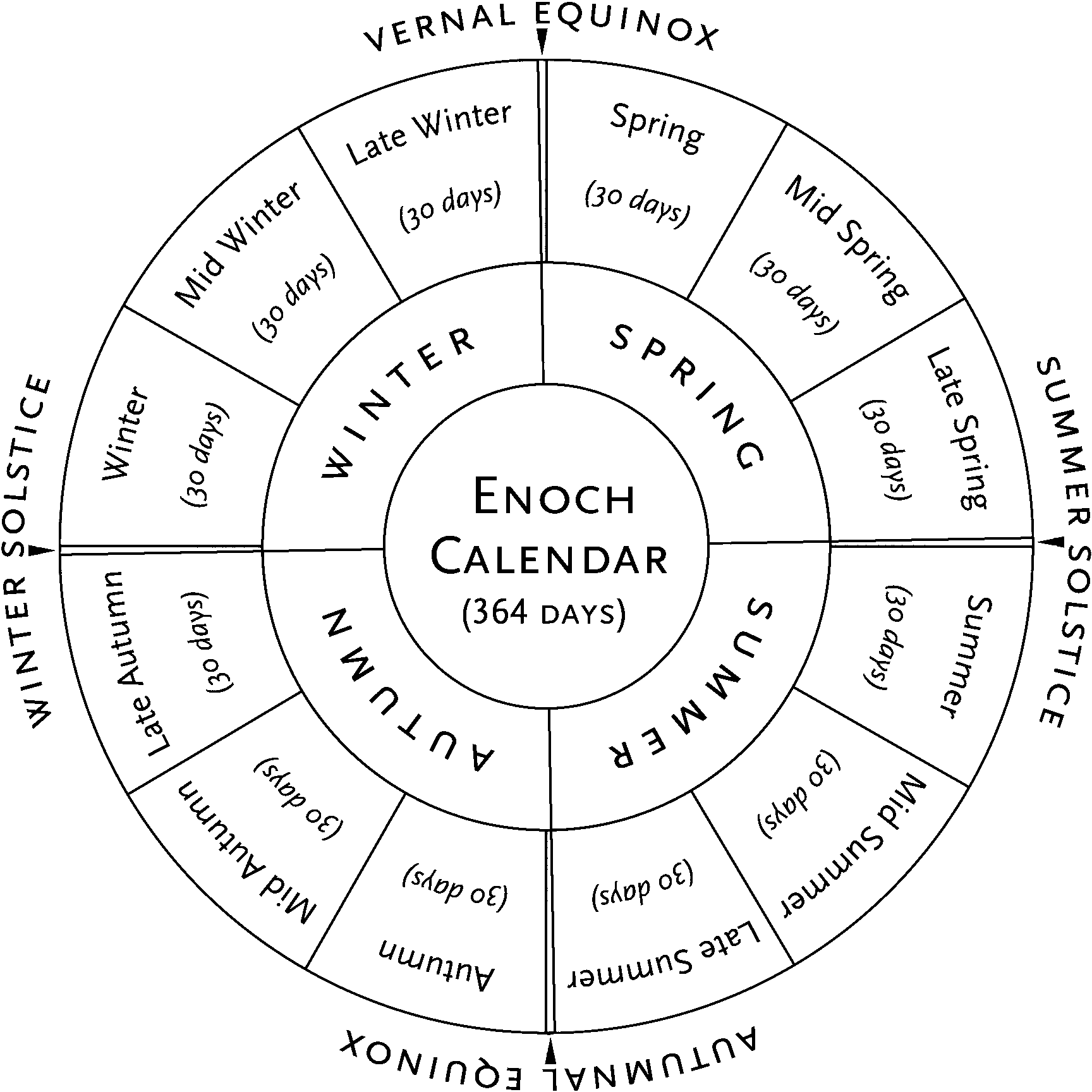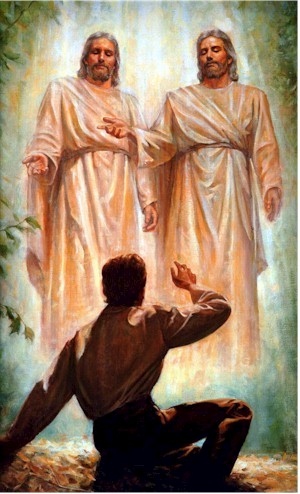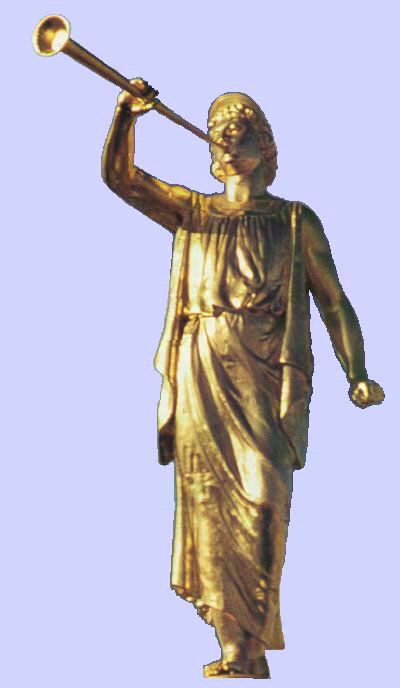
of the First Vision?
Reprinted from Meridian Magazine (5 Aug 2002)
©2002 by John P. Pratt. All rights Reserved.
| 1. Day-Year Pattern |
| 1.1 The First Vision |
| 1.2 Scribe Set Apart |
| 1.3 Passover Meditation |
| 1.4 Continuation of the Pattern |
| 2. Another Witness |
| 2.1 Moroni's Trump |
| 2.2 Church Born |
| 2.3 Revelation on Priesthood |
| 2.4 Return of Elijah |
| 3. Conclusion |
| Notes |
 |
For the purpose of this article, all that is required to know about the calendar is that it is similar to the Hebrew calendar in that it has the same religious feasts and fast days, but it is tied more closely to the week than to the moon. Thus, while the Hebrew year always begins at a new moon, the Enoch year always begins on a Sunday, and most of the holy days occur on either Saturday or Sunday. The dates of celebrating the feasts can vary by weeks from the Hebrew calendar.
The Qumran Calendar. Is there any evidence that the Enoch calendar was ever used by the Israelites for timing their feasts? Yes, it is clear that at least one attempt to do so was made. The community at Qumran, near Jerusalem, shortly before Christ, tenaciously used the "Qumran calendar." They maintained that the other Jewish sects were wrong for using the moon-based calendar for the timing of feasts. A study of the Qumran calendar shows that it had 364 days and many other features of the Enoch calendar. The Qumran society believed that their calendar was the one "true" calendar, and it was apparently derived from an interpretation of the calendar described in the Book of Enoch.
The results of my research imply that they did not get some of the details correct about the Enoch calendar. For example, they began the year on a Wednesday because Genesis states that the light of the sun first appeared on the fourth day of the week of creation (Wednesday). My research shows that the more straightforward interpretation that the year begins on the first day of the week is correct. Thus, at least some Israelites felt that the Enoch calendar should be used for the timing of the feasts. My research indicates that both the Hebrew and Enoch calendars are "correct" but they are used for different purposes. The Hebrew calendar seems to used more for the timing of the births and deaths and notable historical events, whereas the Enoch calendar is more for religious events which generally would not make the headlines.[2] Another important use of the calendars seems to be that they can provide two witnesses of the significance of a date.
 |
Begin with Christ. Another conclusion from last month's article is that Jesus Christ was born in a SUNDAY year (1 BC). Let us define that year to be named 1 SPRING on the Enoch calendar. That is, it is here proposed that the birth year of the Savior was the year corresponding to the New Year's Day on the Enoch calendar. From that starting year, every year in history can be easily identified on the Enoch calendar by simply counting "great years" of 364 years each.
Let us now consider some key dates of the restoration of the Church of Jesus Christ of Latter-day Saints to see if there is a pattern of significance relating to the Enoch calendar. If only one date aligns on some special date on the Enoch calendar, then it might be due to chance. If a few dates align then the evidence is better, but chance is not ruled out. But if several dates align according to the pattern of the known symbolism of holy days, then the evidence becomes strong that the Lord may well be scheduling events on the calendar which was revealed to the Prophet Enoch.
Let us then consider the following day-year combinations to see if perhaps there is a pattern which the Lord might have used in restoring the gospel according to his own calendar. Did anything significant occur on the day 1 Spr 1 SPR, which would be the New Year's Day of the New Year's Year? Or what about 10 Spr 10 SPR, which would be the day of Consecration in the year of Consecration, symbolizing the day when the Passover lamb is to be set apart? That is a day which might be associated with priesthood ordinations. It also refers to being set apart for the sacrifice, which seems especially relevant to the prophet Joseph Smith, who would go as a lamb to the slaughter. And what about the day 14 Spr 14 SPR, the day of Passover in the year of Passover? Let us look at each of these for possible significance, remembering that each of those days only occurs once every 364 years.
 |
This result is still not conclusive because the date of the First Vision has not been known to the Church, other than it occurred on a "beautiful, clear day early in the spring" of 1820 (JSH 1:14). In support of the proposed date, note that the First Vision most likely occurred on a Sunday. That would have been the day on which a farm boy like Joseph Smith would have been able to take some time to go to a grove of trees to pour out his heart in mighty prayer. It is also the day now set aside by the Lord for sacred occasions, so it would require an explanation if one proposed that the First Vision were on a day other than Sunday.
The Spirit calls a Prophet. Related to this date is another striking date. After sunset on Fri 24 Mar 1820 several sacred calendars aligned which have been discussed in previous articles. That evening began the day 10 Nisan on the Hebrew calendar, which is the day of Consecration, the day for choosing a new lamb (Exo. 12:3). It was also 1 Wind on the Native American Sacred Round, the day of the Spirit (Wind). It was also the day 1 Prime on the Mercury Calendar, the holy day symbolic of being at the prime of life. And that evening most likely began the day 0 Spr on the Enoch calendar, the day of the Spring Equinox.[4] This is an example of several sacred calendars aligning to testify of the importance of a date. The four witnesses even suggest a precise interpretation: it is a day for the Spirit to choose a new prophet who has just come of age.
This date is so striking that it would be a candidate for the date of the First Vision, except that the alignment occurred after sunset and before midnight. That evening, however, might have been when Joseph Smith was reading the passage James 1:5, and the Spirit caused the scripture to "enter with great force" into every feeling of his heart (JSH 1:12). He could have pondered it all day Saturday, and then "at length" decided to pray on Sunday morning.[5]
 |
Had I been asked to speculate as to what should have happened on 10 Spr 10 SPR, my guess would have been the ordination of the Prophet to the priesthood. The year (1829) would have been correct (10 SPRING), but not the day, because Joseph was ordained to both the Aaronic and Melchizedek priesthoods later that year. The day Fri 15 May 1829, on which the Aaronic Priesthood was restored, is a mystery to me, for it doesn't appear to be a holy day on any calendar. The Lord's ways are not our ways, so it is very hard even to understand the past, let alone to predict the future. Thus, while anyone can look at future dates on a calendar, I have no intention of ever predicting what will happen on any specific day. There are just too many possibilities, and they are mostly only obvious after the fact. In this case, 20-20 hindsight shows that 10 Spr 10 SPR was clearly the perfect day to select the official scribe for the Book of Mormon.
The day Sat 6 Apr 1833 was General Conference. It was a very significant day calendrically, being Passover on the Hebrew calendar (15 Nisan), and a "saros century" of 1,803 years since the Savior began his public ministry on Sat 6 Apr AD 30, 15 Nisan, 14 Spr. A saros century is an interval after which the Hebrew and Enoch calendars both repeat exactly for several years.[7]
So did anything interesting happen at General Conference on Sat 6 Apr 1833? Yes, the Prophet Joseph Smith made several remarks about the calendrical significance of the date:
The day was spent in a very agreeable manner, in giving and receiving knowledge which appertained to this last kingdom—it being just 1800 years since the Savior laid down His life that men might have everlasting life, and only three years since the Church had come out of the wilderness, preparatory for the last dispensation. The Saints had great reason to rejoice: they thought upon the time when this world came into existence, and the morning stars sang together, and all the sons of God shouted for joy; they thought of the time when Israel ate the "Passover," as wailing came up for the loss of the firstborn of Egypt; they felt like the shepherds who watched their flocks by night, when the angelic choir sweetly sang the electrifying strain, "Peace on earth, good will to man;" and the solemnities of eternity rested upon them. (DHC 1:337)
When is the last time that you remember the Prophet suggesting at General Conference that it would be a good time to think about Passover? Conference often occurs on Passover, as it did then, but it is rarely a topic discussed. But with the recognition of the Enoch calendar, a greater significance is seen: it was not only Passover on both the Enoch and Hebrew calendars, it was also the Enoch PASSOVER year.
 |
So from this occurrence several conclusions seem reasonable. The date clearly fits the expected pattern that a Passover-like event should happen that day. In fact, the saints thought about many Passover-related events. This is the second significant evidence that the Lord is at least aware of the day-year pattern of the Enoch calendar. But it also shows that the day-year pattern is not the primary criterion for the Lord's choice of a date. It was not used for the founding of the Church nor the restoration of the priesthood. The day on which Oliver Cowdery began to be a scribe and the subject matter of General Conference might have both been overlooked in Church history, without anyone having complained about a great oversight in record keeping. It must be remembered that the Lord has several sacred calendars, but this evidence supports the conclusion that the Enoch calendar is indeed one of them.
| Gregorian Date | Enoch Date | Holy Day | Event |
|---|---|---|---|
| Sat 26 Mar 1819 | 0 Spring 0 SPR | Spring Equinox | ? |
| Sun 26 Mar 1820 | 1 Spring 1 SPR | New Year's Day | probably First Vision |
| Tue 7 Apr 1829 | 10 Spring 10 SPR | Consecration | Oliver Cowdery begins |
| Sat 6 Apr 1833 | 14 Spring 14 SPR | Passover | Passover Meditation |
| Sun 6 Apr 1834 | 15 Spring 15 SPR | Easter | ? |
| Sat 11 Apr 1840 | 21 Spring 21 SPR | Last Day Passover | ? |
| Sun 20 May 1883 | 4 Late Spr 4 LSPR | Firstfruits | ? |
| Sat 18 Jun 1910 | 0 Summer 0 SUM | Summer Solstice | ? |
| Sun 25 Jun 1911 | 1 Summer 1 SUM | First Day Summer | ? |
| Sat 22 Sep 2001 | 0 Autumn 0 AUT | Autumn Equinox | ? |
| Sun 22 Sep 2002 | 1 Autumn 1 AUT | Feast of Trumpets | ? |
| Mon 4 Oct 2010 | 9 Autumn 9 AUT | Day of Atonement | ? |
| Sat 3 Oct 2015 | 14 Autumn 14 AUT | Feast of Tabernacles | ? |
| Sat 15 Oct 2022 | 21 Autumn 21 AUT | Last Day Tabernacles | ? |
Twin Towers: Tue 11 Sep 2001. Looking at this table, which is only part of one 364-year cycle, one might notice that the date Sat 22 Sep 2001 is very near to the date of the destruction of the Twin Towers on Tue 11 Sep 2001. Is that significant? It is tempting to say that it is, because the seven priests associated with the related Feast of Trumpets each give a blast on the trump, apparently symbolizing the seven angels who blow their trump heralding the Millennium (Rev. 8:1-2; D.&C. 88:92-110). And sometimes the trumpet blasts of angels shake the earth and cause things to fall down. For example, the seven priests who blew their trumpets when the walls of Jericho fell down seem to represent those angels and the events of the seventh cycle of time (Joshua 6).[8]
Notwithstanding this symbolism, I don't think that the Twin Towers event is directly related to the Enoch calendar for two reasons. First, it didn't occur on the exact day indicated as is usual when the Lord's hand is involved. Secondly, the Enoch calendar is usually used for priesthood purposes. World events which are caused by the Lord are more often scheduled on other calendars.
The destruction of the Twin Towers is, however, entirely in keeping with the theme of the Feast of Trumpets as a voice of warning, announcing the Judgment Day. It was a significant event which called the United States to repentance and served warning that if they cease to be a Christian nation, they will be judged accordingly (Ether 2:8-12).
Feast of Trumpets, Sun 22 Sep 2002. The next date on the above table is Sun 22 Sep 2002, which occurs next month. It is the fall equivalent of the proposed date of the First Vision, and it might be even more important, because it is the fall festivals which pertain to the latter days, even as the spring festivals pertained to the meridian of time. As established above, I have no ability to predict what might happen on that date, other than to expect it to be a little publicized yet significant religious event relating to the coming judgments of God. But it does seem like an appropriate time to celebrate, because the Feast of Trumpets is all about the angels heralding the Millennium, being the first day of the seventh month (first day of the seventh period of time). Thus, because we are already in the beginning of the seventh thousand years from Adam, which began at the dedication of the Palmyra Temple on Thu 6 Apr 2000 (1 Nisan), this might be the most important occurrence of the Enoch Feast of Trumpets in history. But it is important to understand that the Feast of Trumpets is only a feast. It symbolizes the coming judgments of the world, but the Enoch calendar is ahead of the other calendars which are usually used for world events. It is apparently to warn the saints somewhat ahead of time of judgments that are coming bye and bye, rather than to reveal timing details. Thus, the meaning of this feast is most likely that now is the time to get our lives in order, which is just what the living prophet has told us.
Accordingly, a Millennial Feast of Trumpets celebration will be held in Orem, Utah on the night of Fri 20 Sep 2002, which corresponds to the beginning of the day 0 Aut, the Fall Equinox. Next month's article will discuss the Feast of Trumpets, with a link to a presentation which might be appropriate for a family celebration.
 |
Autumn Equinox. Even with this rich symbolism, I have been cautious about claiming too much importance for the delivering of the plates on the Feast of Trumpets because some alignments could occur by chance. The transfer of the plates seemed more closely tied to the autumn equinox because Angel Moroni made a point of returning every year on the date of the equinox (22 Sep). It is important that a pattern emerges which truly testifies of the hand of intelligence. The Lord will always provide a pattern so that we won't be deceived (D.&C. 52:14). When one checks other dates in Church history, only a few alignments are found with the Hebrew calendar. Fortunately, now that the Enoch calendar is understood, the pattern is becoming clear.
Most dates in Church history which are significant on the Hebrew calendar were also holy days on other sacred calendars.[10] My caution about ascribing too much importance to the dark, early morning on which the golden plates were delivered was partly because Sat 22 Sep 1827 was a sacred day on only one calendar known to me.
Two Witnesses. The Lord apparently always provides at least two witnesses that a date was planned and not just a chance coincidence. Those two witnesses might be a day-year alignment (day and year counting separately), or be holy days on two different calendars, or be any of several other witnesses. Now that the Enoch calendar is understood, we have a second witness to the importance of the date of delivering the plates.
The day Sat 22 Sep 1827 was the Fall Equinox on the Enoch calendar (0 Autumn), the holy day preceding the Feast of Trumpets (1 Autumn). Thus, it was a doubly sacred day, and there are indeed two witnesses of its importance. Moreover, the second witness is tied to the autumn equinox which seemed to be the symbolism Moroni used in his other visits.
With the discovery of the Enoch calendar, it now becomes clear that the alignment of the founding of the Church with a sacred day was with the Enoch calendar rather than the Hebrew calendar. The day Tue 6 Apr 1830 was the day 10 Spr, the day of Consecration. As we continue looking at dates, it appears that the Enoch calendar may be more significant than the Hebrew calendar for timing events of the restoration of the Gospel.
There is another great lesson to be learned here from what the Lord did not do. From the fact that the Church was not founded on the wonderfully significant day Sat 6 Apr 1833, it is also clear that the Lord avoids the obvious. By so doing, neither Satan nor anyone else can know in advance just what his plans are, simply by looking at his revealed calendars. It is only in retrospect that the calendars become witnesses of his intelligent design and foreknowledge.